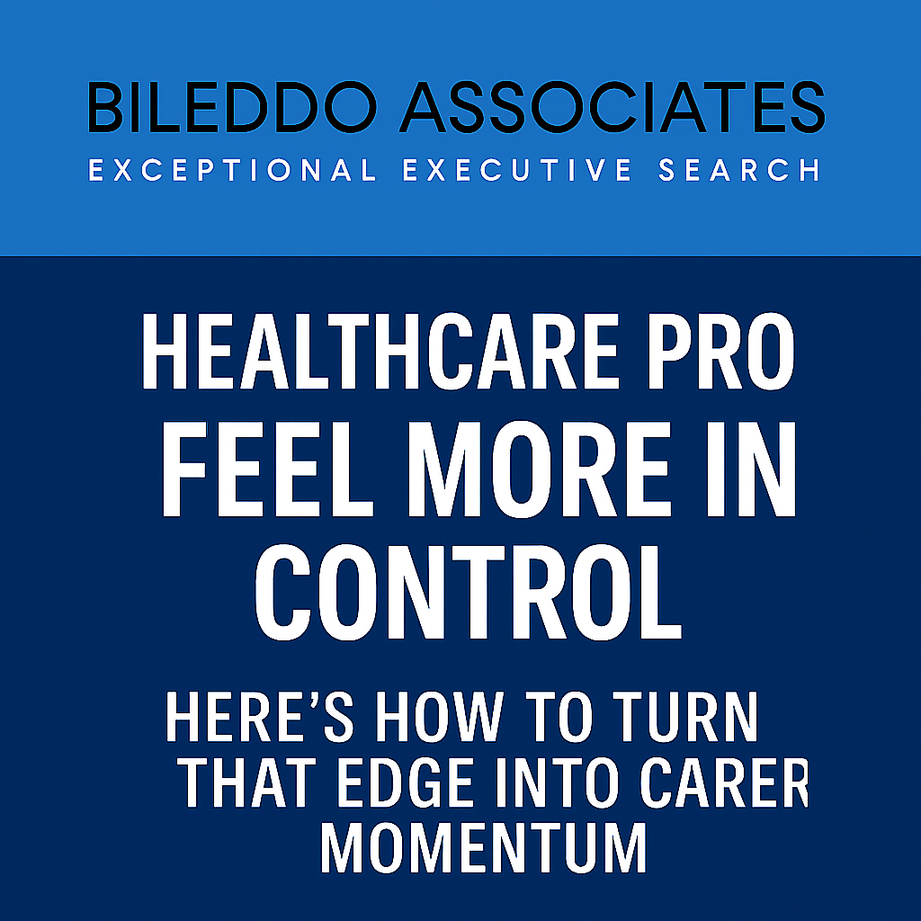
A new LinkedIn News survey found 57% of healthcare professionals feel in control of their careers vs. 45% across all industries. That confidence is a competitive advantage—but it’s only realized when leaders, hiring teams, and candidates turn it into action.
What the data says (and why it matters)
Who feels most in control: Business development (59%), healthcare (57%), accounting (56%), HR (55%), real estate (53%).
Who feels least in control: Customer success/support (33%), media/communications (36%), marketing/research/administrative (39%).
What’s driving the gap: Rapid role shifts—especially in fields being reshaped by AI. In healthcare, predictive AI is accelerating inside hospitals, but adoption varies by system vs. independent facilities.
On the ground: Nurse informatics leaders report AI’s most immediate lift is reducing documentation burden, freeing clinicians to do more of what only people can do: care, lead, and solve.
Bottom line: Healthcare’s sense of control is real—but uneven. Organizations that channel it into clearer career paths, faster hiring, and better onboarding will win talent and results.
For Hospital & Health System Leaders: Turn “control” into outcomes
1) Make growth visible.
Publish internal mobility maps for clinical and non-clinical roles (e.g., RN → Assistant Nurse Manager → Nurse Manager → Director; Analyst → Revenue Cycle Manager → AVP). Clear paths transform confidence into retention.
2) Cut time-to-hire in half.
Where candidates feel in control, they also feel free to walk. Pre-build two panels, a structured scorecard, and a 48–72 hour calendar hold for final interviews. Speed = signal.
3) Use AI to remove friction, not add it.
Start where the ROI is obvious: documentation assistance, scheduling optimization, and smarter requisition routing. Pilot with a single unit, measure impact, then scale.
4) Equip leaders to lead change.
Invest in manager toolkits: weekly huddles, 30/60/90 onboarding, and “stay interview” prompts. The best retention plan is a great first 90 days.
5) Build your “always-on” leadership bench.
Keep warm slates for hard-to-fill roles (Periop, ED, Quality, Revenue Cycle). When a vacancy hits, you’re interviewing in days, not months.
For Healthcare Candidates: Keep your hands on the wheel
1) Clarify your next 2 moves.
Don’t just aim for a title—aim for skills. Choose two capabilities that raise your ceiling (e.g., throughput redesign, value-based care analytics, periop block optimization).
2) Make AI your co-pilot.
Learn the workflows improving your unit—especially those easing documentation and handoffs. Fluency here is career rocket fuel.
3) Tell a business story.
Quantify outcomes in your profile and conversations: reduced premium labor 18% in 90 days, improved door-to-balloon by 12 minutes, lifted HCAHPS top-box 6 pts. Numbers travel.
4) Vet fit, not just offers.
Ask about 30/60/90 goals, decision rights, and data access. Career control is knowing how you’ll win, not just where you’ll work.
5) Nurture your network weekly.
Comment on peers’ wins, share a brief case study, and help someone solve a problem. Opportunity flows to visible value.
The AI reality check—threat or tailwind?
In industries where workers feel the least control (support, media, some marketing functions), AI is displacing repetitive tasks fastest. Healthcare is different: the most immediate gains are augmentative—documentation, triage, throughput, and insight generation. That keeps humans in the loop and raises the value of leaders who can orchestrate people + process + technology.
Translate it practically:
Leaders: Pilot narrow AI use cases with clear success metrics (time back to bedside, reduction in rework, fewer handoff errors).
Candidates: Add one line to your resume: “Piloted AI documentation support on 2 units; reduced average charting time by 28%.”
What this means for 2026 planning
Vacancy costs are compounding. If your time-to-fill exceeds 60 days for leadership roles, you’re paying a hidden tax (premium labor, delayed initiatives, cultural drift).
Mobility beats recruiting in place. Your best hire might be a 12-month stretch promotion with the right guardrails.
Story > posting. The best candidates respond to a compelling business problem, not a generic job description.
How Bileddo Associates helps:
Pre-built shortlists for critical leadership roles so you interview in days.
Structured scorecards & panel guides to de-risk the hire.
90-day onboarding roadmaps to convert momentum into outcomes.
Market intel on compensation, span of control, and time-to-fill to support better offers and faster decisions.
If you’re mapping your 2026 leadership plan—or facing a vacancy now—DM me or comment “PLAN” and I’ll send a quick checklist you can use with your team today.
Suggested headline options for the LinkedIn article
Healthcare Pros Feel More in Control—Here’s How Leaders Can Turn It into Results
#HealthcareLeadership #HospitalLeadership #WorkforceTrends #NurseInformatics #AIinHealthcare #TalentStrategy #Recruitment #CareerGrowth #LinkedInNews #HealthSystems
